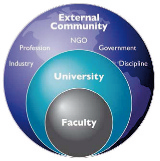
There are numerous sources of evidence that could be utilised by academic staff to demonstrate their achievements in education in myEducation Portfolio. To assist you with compiling your portfolio, please refer to online guides titled Promoting Teaching: Making Evidence Count produced by the UK Higher Education Academy (now known as Advance HE) as well as the Australian University Teaching Criteria and Standards (AUTCAS). Those guides outline the types of evidence that could be used to demonstrate excellence in teaching.
Evidence related to each dimension of myEducation Portfolio may be derived from personal reflection, student feedback and/or peer evaluation. See for example Table 1 below, which lists sources of evidence within the university.
Evidence of reflective practice, professional development and/or commitment to innovation; evidence of engagement with educational literature or theory, e.g. how a teaching philosophy/theory informs the academic’s teaching practice.
How students perceive the work of the academic, through scores in feedback surveys and qualitative comments (including unsolicited comments); measurements of student achievements in courses the applicant has taught, developed or led, and how student feedback scores compare with school averages.
Evidence of recognition by colleagues in their institution including head of school comments, as well as recognition at national or international level. May include peer observations and peer reviews of curriculum development.
Table 1 – Sources of evidence - adapted from Promoting Teaching: Making Evidence Count. Higher Education Academy UK (2013).
The predominant sources of evidence will change over the course of an academic’s career as the scope of their educational activities evolves and their sphere of influence grows (Figure 1). Those proportions will vary based on each individual’s teaching experience and practices.

Figure 1 – Sources of evidence showing changes with level of promotion - from Promoting Teaching: Making Evidence Count. Higher Education Academy UK (2013).
The scope of teaching activities in the Promoting Teaching: Making Evidence Count guide and the UNSW Academic Expectations Framework for education activities align well with the dimensions of myEducation Portfolio (Table 2). Note that the mix of those activities will vary according to academic level and career pathways.
UK Higher Education Academy
UNSW Academic Expectations Framework
Australian University Teaching Criteria and Standards
myEducation Portfolio
Scholarship of learning and teaching
Impact on student learning (Professional development and disciplinary knowledge) &
Impact on educational knowledge
Integration of scholarship, research and professional activities with teaching and in support of learning & Evaluation of practice and continuing professional development
Disciplinary expertise and professional development
Impact on student learning (Delivery)
Teaching and supporting student learning & Developing effective environments, student support and guidance
Teaching and supporting student learning
Impact on student learning (Course and program design and development)
Design and planning of learning activities & Assessment and giving feedback to students
Design and development of learning activities and assessment
Leadership and collaboration
Impact on educational environment
Professional and personal effectiveness
All education-related activities are collaborative. Therefore, academics work within multiple spheres of influence (Figure 2). Typically, academics will extend their sphere of influence as their careers progress.

Figure 2 - Leadership and impact in multiple teaching-related spheres of influence - from Promoting Teaching: Making Evidence Count. Higher Education Academy UK (2013).
This sample guide (based on Promoting Teaching: Making Evidence Count ), which is not intended to be exclusive, sets out a range of evidence that could be used in your myEducation Portfolio from three different perspectives for different academic roles. The shading of each type of evidence indicates the dimension of myEducation Portfolio with which that evidence aligns.
Senior Lecturer Associate Professor and Professor
Include evidence from the following list of examples, choosing those relevant to your context and outlining how they demonstrate innovation, excellence and impact:
Impact on students
Impact on students (continued)
Impact on peers
Impact on peers (continued)
Impact on peers (continued)